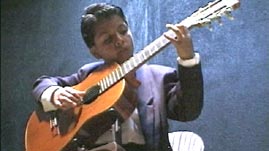Teachers' Domain - Digital Media for the Classroom and Professional Development
User: Preview


Source: ZOOM
(footsteps approaching) (knocking) (creaking)
ANDRES DE LEON GOMEZ: My name is Andres de Leon Gomez. I'm ten years old. There are lots of things I like to do, like playing soccer with my friends.
Best of all is playing the guitar. (playing classical tune) I live in a little town called Paracho, high up in the mountains of Mexico. People say Paracho is "loco", or crazy, about guitars. We've been making them for hundreds of years. Here, while they make guitars, we play them. For me, the best part of living here is fiesta time.
WOMAN: Gracias. (band playing lively music)
GOMEZ: Every August, we celebrate the "guitarreros" or guitar-makers. And we also have competitions for the best guitar player. Tonight, I'm competing in the kids' competition. (playing classical tune)
PROFE: "Llegando" "a la que vas..."
GOMEZ: This is my teacher. We call him "Profe." He's helping me practice.
PROFE: "Sì? Poquito mas."
GOMEZ: (playing same tune) Learning to play all the notes is hard, but then you have to turn the notes into beautiful music. That's what the judges are looking for. I like to imagine that the music is telling a story.
My dream is to be a great guitar player someday. "Me quita la... en..., verdad?" Oh, I've got butterflies in my stomach. Wish me luck. (playing same tune)
ANNOUNCER: "...con Andres de Leon Gomez..." (applause)
GOMEZ: I can't believe it! I won first place! Profe was right-- you can make your dreams come true.
 Loading Standards
Loading Standards Teachers' Domain is proud to be a Pathways portal to the National Science Digital Library.
Teachers' Domain is proud to be a Pathways portal to the National Science Digital Library.
